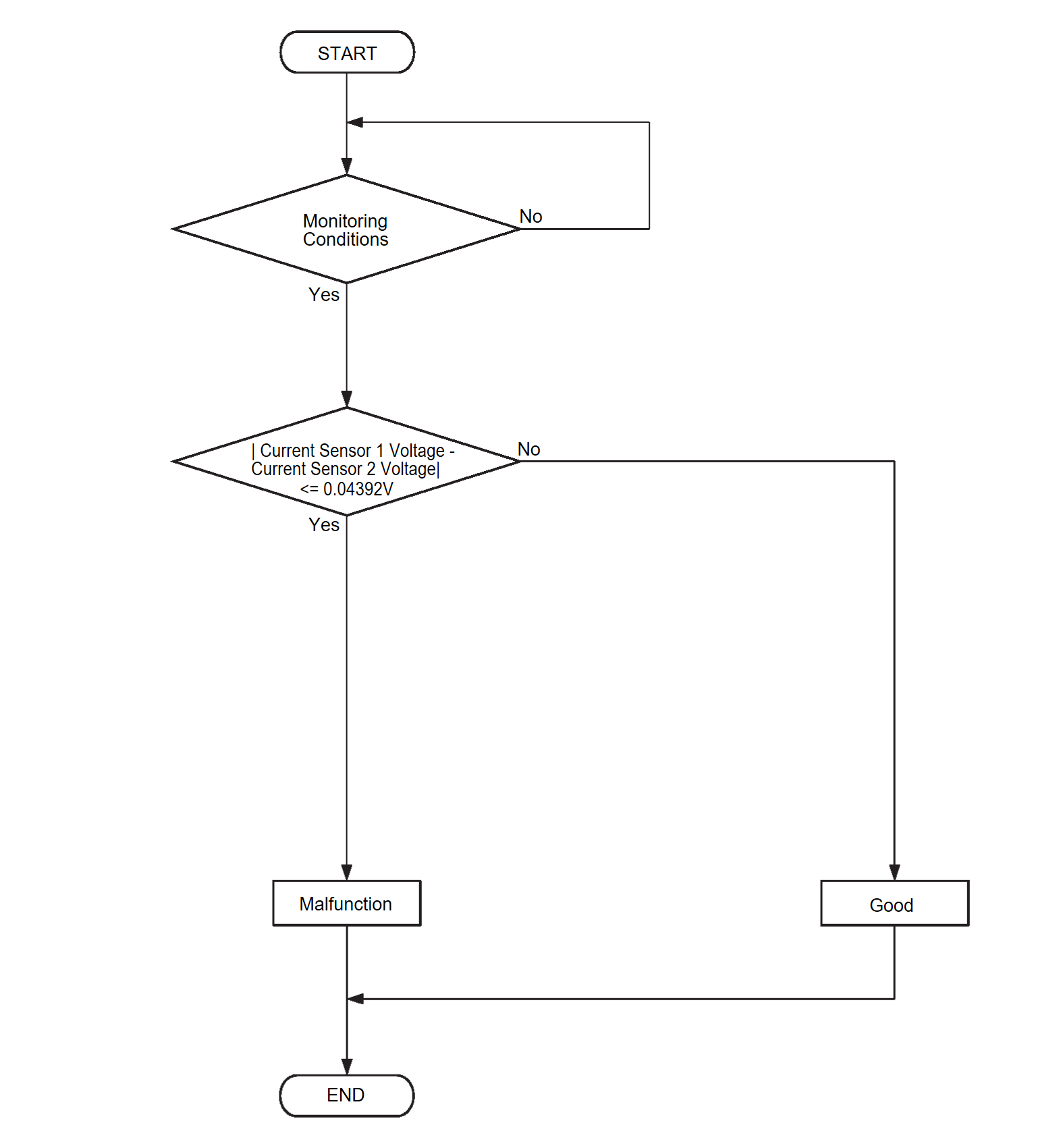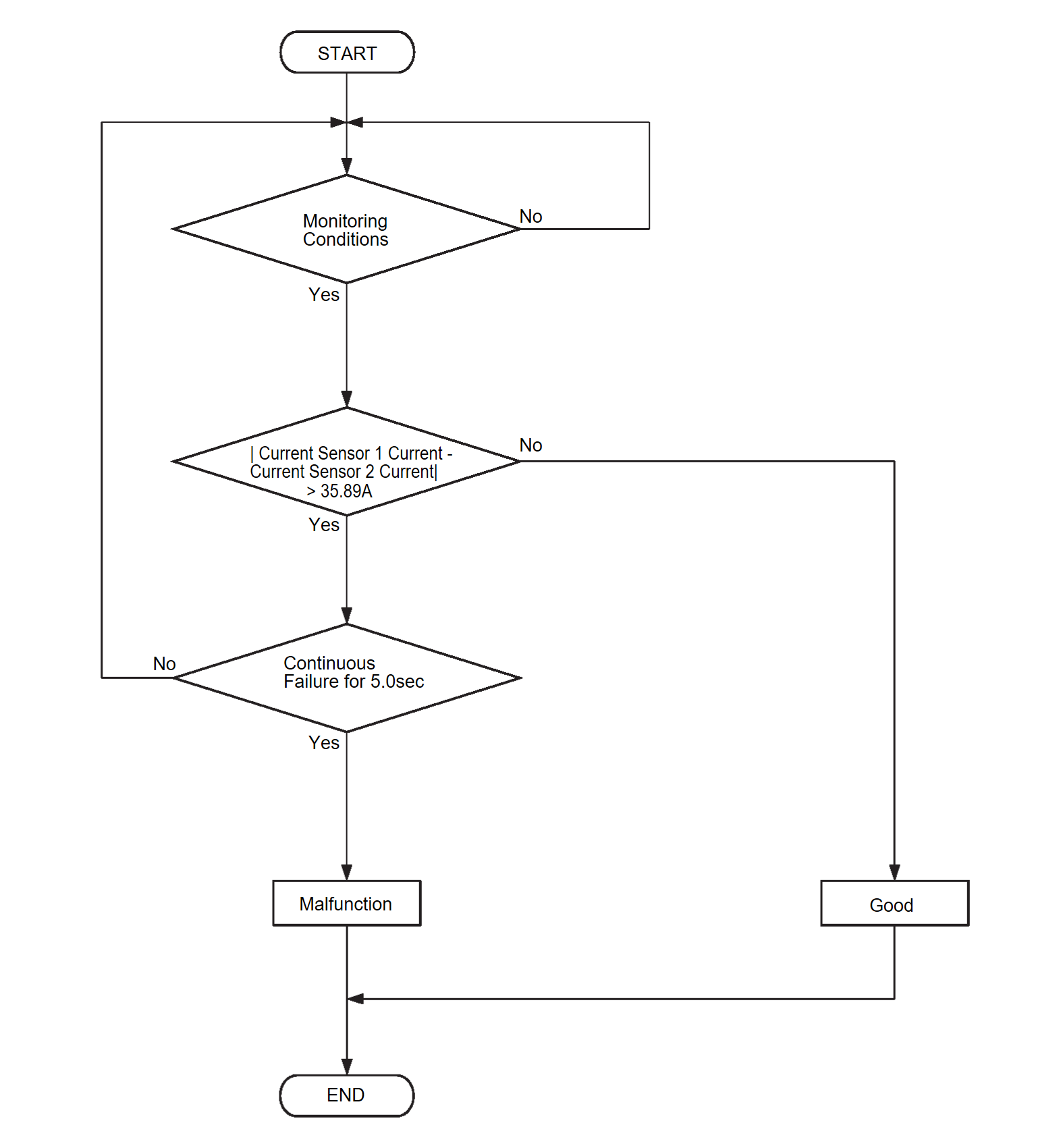DTC No. P0B13-00 Current Sensor Short Diagnosis
MONITOR EXECUTION
Continuous
MONITOR EXECUTION CONDITIONS (Other monitor and Sensor)
Other Monitor (There is no temporary DTC set in memory for the item monitored below)
- BMU monitor
Sensor (The sensor below is determined to be normal)
- Drive battery current sensor
Check Condition A
- The BMU power supply voltage is more than 7.578 volts.
Check Condition B
- The BMU power supply voltage is more than 7.578 volts.
- The input voltages of the current sensors 1 and 2 are less than 3.46 volts, and more than 3.09 volts.
Judgment Criterion A
- The value subtracting the current sensor 2 input voltage from the current sensor 1 input voltage is 0.04392 volt or less.
Judgment Criterion B
- The value subtracting the current sensor 2 input current from the current sensor 1 input current is 35.89 amperes or more for 5 seconds or more.
OBD-II DRIVE CYCLE PATTERN
- Refer to OBD-II Drive Cycle OBD-II DRIVE CYCLE
 .
.
TROUBLESHOOTING HINTS
- Damaged wiring harness and connectors
- Malfunction of the junction box No. 2
- Malfunction of the BMU
DIAGNOSIS
Required Special Tools:
- MB992744: Vehicle communication interface-Lite (V.C.I.-Lite)
- MB992745: V.C.I.-Lite main harness A
- MB992747: V.C.I.-Lite USB cable short
- MB992748: V.C.I.-Lite USB cable long
- MB991223: Wiring harness set
- MB992006: Extra fine probe
1.Test the OBD-II drive cycle.
(1) Carry out a test drive with the drive cycle pattern. Refer to OBD-II Drive Cycle OBD-II DRIVE CYCLE .
.
 .
.(2) Check the DTC.
Is the DTC set?
 The trouble can be an intermittent malfunction (Refer to General Information - How to Use Troubleshooting/Inspection Service Points, How to Cope with Intermittent Malfunctions HOW TO COPE WITH INTERMITTENT MALFUNCTIONS
The trouble can be an intermittent malfunction (Refer to General Information - How to Use Troubleshooting/Inspection Service Points, How to Cope with Intermittent Malfunctions HOW TO COPE WITH INTERMITTENT MALFUNCTIONS ).
).2.Drive battery control wiring harness check (Current sensor power supply line, signal line, ground line)
(1) Disassemble the drive battery (Refer to SERVICE PROCEDURE ).
).
 ).
).(2) Check the following wiring harness for short to ground circuit.
- Between the BMU connector (ISENV terminal) and junction box No. 2 connector (terminal No. 3)
- Between the BMU connector (ISEN1 terminal) and junction box No. 2 connector (terminal No. 7)
- Between the BMU connector (ISEN2 terminal) and junction box No. 2 connector (terminal No. 9)
(3) Check the following wiring harness for open circuit.
- Between the BMU connector (ISENV terminal) and junction box No. 2 connector (terminal No. 3)
- Between the BMU connector (ISEN1 terminal) and junction box No. 2 connector (terminal No. 7)
- Between the BMU connector (ISEN2 terminal) and junction box No. 2 connector (terminal No. 9)
- Between the BMU connector (SGND terminal) and junction box No. 2 connector (terminal No. 10)
Is the check result normal?
3.Drive battery control wiring harness check (Current sensor power supply line, signal line, ground line)
Check the following wiring harness for damage. Replace the junction box No. 2 and BMU (Refer to SERVICE PROCEDURE
Replace the junction box No. 2 and BMU (Refer to SERVICE PROCEDURE ). Then,
). Then, 
- Between the BMU connector (ISENV terminal) and junction box No. 2 connector (terminal No. 3)
- Between the BMU connector (ISEN1 terminal) and junction box No. 2 connector (terminal No. 7)
- Between the BMU connector (ISEN2 terminal) and junction box No. 2 connector (terminal No. 9)
- Between the BMU connector (SGND terminal) and junction box No. 2 connector (terminal No. 10)
Is the check result normal?
 Replace the junction box No. 2 and BMU (Refer to SERVICE PROCEDURE
Replace the junction box No. 2 and BMU (Refer to SERVICE PROCEDURE ). Then,
). Then, 
4.Test the OBD-II drive cycle.
(1) Carry out a test drive with the drive cycle pattern. Refer to OBD-II Drive Cycle OBD-II DRIVE CYCLE .
.
 .
.(2) Check the DTC.
Is the DTC set?
 Retry the troubleshooting.
Retry the troubleshooting. The procedure is complete.
The procedure is complete.![[Previous]](../../../buttons/fprev.png)
![[Next]](../../../buttons/fnext.png)

